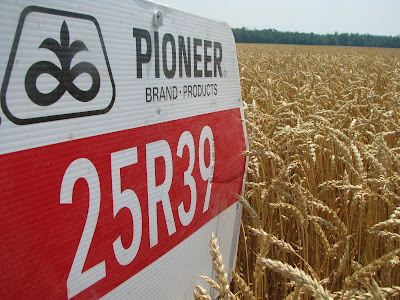 Pioneer brand 25R39 is a new soft red winter wheat for 2010 fall.It has performed extremely well in both on farm plot comparisons as well as the OCCC Winter Wheat Trials.Pioneer yield data would support 25R39 as the highest yielding soft red winte wheat variety that has ever been released from Pioneers wheat breeding research.
Pioneer brand 25R39 is a new soft red winter wheat for 2010 fall.It has performed extremely well in both on farm plot comparisons as well as the OCCC Winter Wheat Trials.Pioneer yield data would support 25R39 as the highest yielding soft red winte wheat variety that has ever been released from Pioneers wheat breeding research. Pioneer brand 25R56 is also a relatively new Pioneer soft red winter wheat that has also performed extremely well.Both varietes have greater genetic yield potential than Pioneer 25R47. 25R56 is a bit shorter soft red wheat than 25R39.No-til farmers preferring less residue may have a preference for 25R56 while those liking more residue or baling their straw may prefer 25R39.Both varieties should prove to offer additional yield
Pioneer brand 25R56 is also a relatively new Pioneer soft red winter wheat that has also performed extremely well.Both varietes have greater genetic yield potential than Pioneer 25R47. 25R56 is a bit shorter soft red wheat than 25R39.No-til farmers preferring less residue may have a preference for 25R56 while those liking more residue or baling their straw may prefer 25R39.Both varieties should prove to offer additional yield opportunity for the Ontario farmer.

















